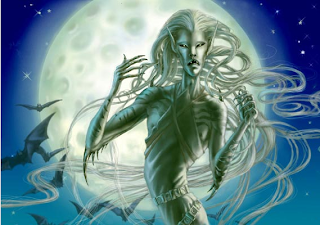1.a branch of the Indo-European family of languages, including especially Irish, Scots gaelic, Welsh, and Breton, which survive now in Ireland, the Scottish Highlands, Wales, and Brittany. Abbreviation: Celt". For a more in depth description you can visit http://en.wikipedia.org/wiki/Celts.
Personally, images have always worked better than than written descriptions when it comes to formulating themed creations. When you do an image search on Google for Celtic one of the first things that pops up are Celtic knot designs. Generally speaking, Celtic knots represent the repeated crossings of the spiritual and physical paths in our lives and the permanence and continuum of life, love, and faith.
Some of our members have already come up with some lovely jewelry incorporating versions of Celtic knots. But what if you're looking for something a little different?
One of our members suggested searching Celtic Mythology for something beyond just Celtic knot designs. One prominent image is the Celtic Green Man. In Celtic mythology the Green Man is a god of Spring and Summer who disappears and returns year after year enacting themes of death and resurrection and the ebb and flow of life and creativity. This is certainly something artists and crafters can relate to!
Another prominent figure in Celtic mythology is Epona, the Horse Goddess (and one of my favorites). Sometimes Epona is depicted as a woman, and sometimes as a white mare. Epona was the protector of horses and other equines and was a goddess of fertility. Some believe that Epona and her horses were the leaders of the souls in the afterlife ride.
And then there are the Celtic fairies, which come a quite an array of sizes, shapes and styles. Celtic folklore is filled with supernatural creatures, many of which are considered fairies, commonly called faerie or fey folk. These can include the little people, leprechauns, and banshees. Modern versions of Celtic fairies abound in the artistic world as well.
I hope this helps clarify the meaning and imagery behind the word "Celtic". This post is by no means comprehensive, just a tiny sampling of some of the legends, symbols, and mythology connected to the Celts. I hope this helps spark a bit of inspiration for the Smooshers Celtic Challenge and an appreciation for all things Celtic ;-)









1 Smooshing Thoughts:
Hi there. Would you please credit me for the use of my original illustration of the Epona illustration? I am happy for my work to be shown on personal blogs and educational websites, etc. but would like to be credited so people can look me up if they like my work.
If you'd like to be especially helpful, you could link to my Etsy shop where I have a print of it available: https://www.etsy.com/listing/160039015/epona-goddess-illustration-print-in
However, a credit of "Joanna Barnum" would be sufficient.
Here is where the illustration appears on the first edition of my website: http://www.joannabarnum.com/gallery/pinup/epona
Meanwhile, as I post newer art online, I am being more diligent about include built in watermarks on my artwork to make it easier for people to share and credit me, since I know it can sometimes be hard to track down the original source of a work once it starts floating around online.
Thanks so very much for your cooperation and understanding!
Post a Comment